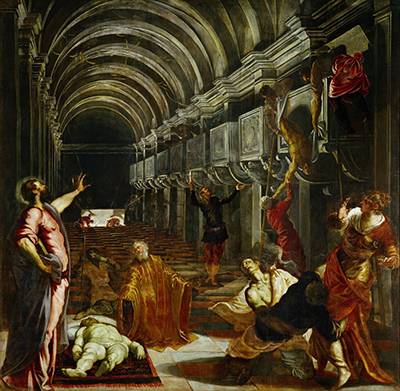The Finding of the Body of St Mark continues the dark tones that dominated the last two decades of Tintoretto's career.
This particular painting is dated at around 1562-1566 but this date more reflects the difficulty in accurately dating paintings from this long ago rather than any expectation that the artist would have needed four years to complete it. Despite its great level of detail, Tintoretto simply worked at a far greater pace than most other artists and so would have more likely needed just several weeks.
In his later years the artist would concentrate on larger paintings and spend more time on each, rather than the insanely busy production line of his earlier period. This sprawling piece is over three metres tall and wide, also showing off some of the developments that the artist had made in architectural perspective. Everything in the painting, other than the figures themselves, lead to a vanishing point that sits towards the back of the painting.
Tintoretto produces such a moody atmosphere in this painting, it feels almost like something from the French Romanticist or Expressionist eras. Compare it to the likes of Theodore Gericault's The Raft of the Medusa or Eugene Delacroix's Liberty Leading the People, for example, and you will find the same darkness several centuries later.
The painting is part of an excellent collection of Tintoretto highlights at the Gallerie dell'Accademia in Venice. Renaissance followers can also enjoy the likes of Paolo Veronese, Vittore Carpaccio, Hieronymus Bosch, Giorgione, Andrea Mantegna and Piero della Francesca here. This venue has perhaps more of the Venetian's work than any other single institution in Italy. and is a great place to start for those looking to understand his work more clearly.




